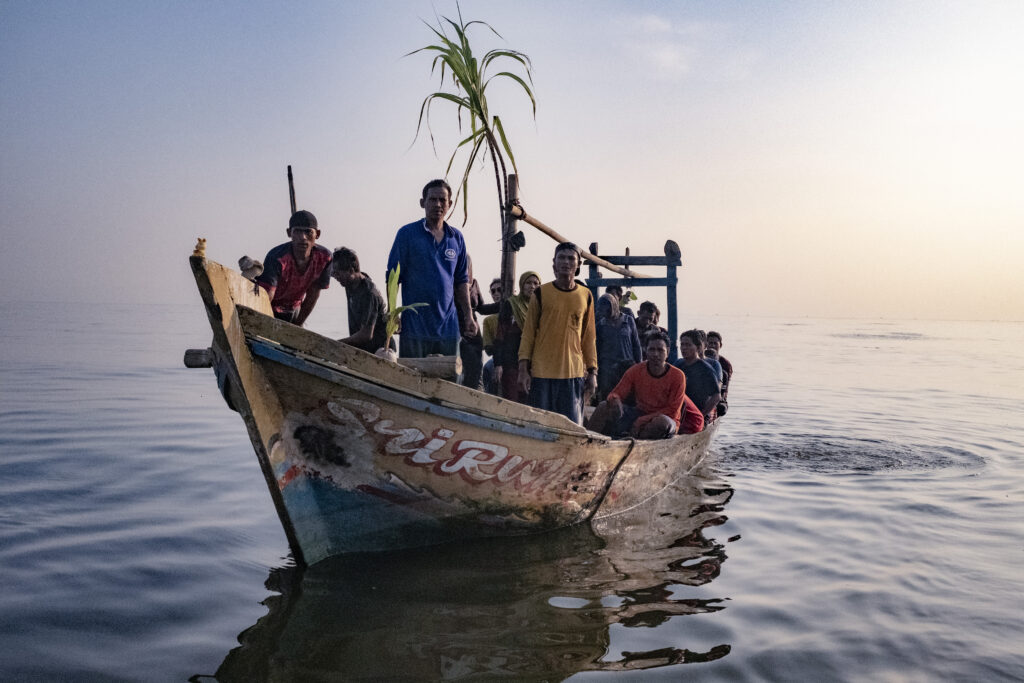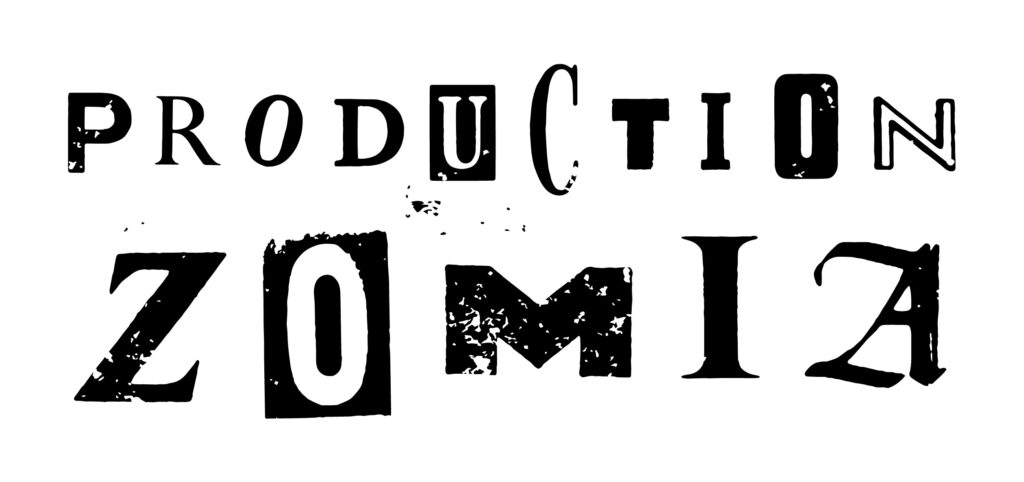Irwan Ahmett & Tita Salina
Sri Rumput
2023, Video 1 Channel, 5’11”

Since Moses parted the sea, or a ship ran aground off the coast which depicted in the painting La Balsa de Medusa[1], or a massive flood in the island of Java in 1861 which depicted in Raden Saleh’s painting A Flood on Java[2], water still holds horror as well as aesthetic and be the estuary of various accompanying narratives. Personally, the relation between water and human starts from the womb that makes us capable to dive various meanings resonate from archaic relation – as water is the carrier material of life and death.
Sri Rumput (beautiful grass) is a name of an abandoned old boat by the estuary of Muara Angke, North Jakarta which then Irwan and Tita adopted it to become the ark of imagination representing the land and water.
During a deep encounter in Muara Angke fishermen settlement, Irwan and Tita came into contact with sea tides also the bright and dark sides of the coastal settlement (kampung) grassroots. The nautical allegiance in their blood has been slowly fading out along with pressure to survive concurrently with the collapsing of environmental carrying capacity. Go to sea for fish has no longer been a hope when the climate is increasingly unfriendly, while trying to switch to being a farmer but lands have been sold out. The onslaught for land grabbing and land conversion came from all directions, amidst the emergence of man-made islands built from destroyed mountains in areas adjacent to Jakarta that have been extracted for years. Meanwhile, sand mining, quarries, and property speculators are dancing in the investment bubble, the anthropocentric giant sea wall project to protect Jakarta from sinking is like breathing underwater. What is inhaled is the rush to move the capital from Jakarta to East Kalimantan province, which was shrouded in nationalism and identity politics reeking of oligarchy.
[1] La Balsa de Medusa (1818 – 1819), an oil painting by the French Romantic painter and lithographer Jean Louis Théodore Géricault (1791 – 1824).
[2] Overstroming op Java (A Flood on Java) (1863-1876), an oil painting by the Arab-Javanese Romantic painter Raden Saleh (1811 – 1880).
Credits:
Song: Bersemi Sekebun
Written by: Efek Rumah Kaca
Concept & Director: Irwan Ahmett
Co-Director: Tita Salina
Cameramen: Yopie Nugraha, Rangga Aditiawan, M. Faizur Rahman, Pak Warjo
Aerial: Jin Panji, Irwan Ahmett
Editor: M. Faizur Rahman
Logistic & Equipment: Aditya Megantara
Artistic: Didi Tarmidi
Field Coordinator: Yuda Samakta
Local Coordinator: Pak Sukari
Boat passengers:
Kasdi, Donal, Atam, Acong, Warno, Takimin, Suerin, Sarki, Juanda, Dodo, Akbar, Pak Waji, Muari, Udin, Mista, Ogut, Badrul, Darto, Jagur, Rastono, Agung, Sobari, Pak Sukari, Tita, Mama Zulfa, Mama Eki, Pak Jegres, Pak Darwan, Pak Agung, Intan, Sari, Petuk.
Compressor divers:
Pak Warjo, Pak Udi, Bang Acong
Thanks to:
Pak Maming, Pak RW Bani, Bu Tati, Binggo, Jaringan Rakyat Miskin Kota (JRMK), Bu Siti, Rahman, Sarah, Messi, Wati si beruk, Om Riyan, children of the river, resident of block Empang settlement in Muara Angke fishing port, North Jakarta and Jakarta Legal Aid Institute.
Commissioned by: Efek Rumah Kaca
อีร์วัน อะห์เมตต์ และ ติตา ซาลินา
ทุ่งหญ้าที่สวยงาม
2023, วีดิทัศน์, 5’11”

นับตั้งแต่โมเสเแยกน้ำทะเล หรือเรือเกยตื้นนอกชายฝั่งซึ่งปรากฏในภาพวาด แพแห่งเมดูซ่า[1] (La Balsa de Medusa) หรือน้ำท่วมใหญ่บนเกาะชวาในปี 1861 ซึ่งได้ปรากฏในภาพวาดของราเดน ซาเลห์ ในชื่อ อะ ฟลัด ออน ชวา[2] (A Flood on Java) น้ำยังคงมีความน่าหวาดกลัวและสวยงามอยู่เสมอ อีกทั้งยังเป็นปากอ่าวของเรื่องเล่าประกอบที่หลากหลาย โดยส่วนตัวแล้ว ความสัมพันธ์ระหว่างน้ำกับมนุษย์นั้นเริ่มต้นจากแหล่งกำเนิดที่ทำให้เราสามารถดำดิ่งไปสู่ความหมายต่าง ๆ ที่สะท้อนมาจากความสัมพันธ์อันเก่าแก่ – เพราะน้ำ เป็นพาหนะของชีวิตและความตาย
ศรี รุมปุต (ทุ่งหญ้าที่สวยงาม) เป็นชื่อของเรือเก่าที่ถูกทิ้งร้างข้างปากแม่น้ำมุอะรา อังเก ในตอนเหนือของจาการ์ตา ซึ่ง ณ ขณะนั้น อีร์วัน และติตาได้นำมาใช้จนกลายมาเป็นหีบแห่งจินตนาการอันเป็นตัวแทนแห่งผืนดินและผืนน้ำ
ในระหว่างการเผชิญหน้ากันอย่างเข้มข้น ณ ชุมชนชาวประมงมุอะรา อังเก อีร์วันและติตาได้เข้ามาสัมผัสกับกระแสน้ำทะเลรวมทั้งด้านสว่างและด้านมืดของการตั้งถิ่นฐานที่ชายฝั่ง(กัมปุง)ในระดับรากหญ้า ความจงรักภักดีต่อทะเลในเลือดเนื้อของพวกเขาค่อย ๆ จางหายไปพร้อม ๆ กับความกดดันในการมีชีวิตให้รอดควบคู่ไปกับการพังทลายของความสามารถในการแบกรับต่อสิ่งแวดล้อม การไปตกปลาในทะเลไม่ใช่ความหวังอีกต่อไปเมื่อสภาพอากาศไม่เอื้ออำนวยมากขึ้น ขณะที่ลองพยายามเปลี่ยนมาเป็นเกษตรกรแต่กลับขายที่ดินไปหมด การบุกรุกโจมตีเพื่อแย่งชิงที่ดินแและการแปลงการใช้ประโยชน์จากที่ดินมีมีจากทุกทิศทาง ท่ามกลางการเกิดเกาะที่มนุษย์เป็นคนสร้างโดยการทำลายภูเขาในบริเวณพื้นที่ติดกับจาการ์ตาที่ถูกขุดขึ้นมานานหลายปี ขณะเดียวกัน การทำเหมืองทราย เหมืองหิน และพวกนักเก็งกำไรอสังหาฯ ต่างกำลังร่ายรำอยู่ในฟองสบู่ของการลงทุน โครงการกำแพงกันคลื่นในทะเลขนาดยักษ์ใหญ่ที่มีมนุษย์เป็นศูนย์กลางเพื่อปกป้องจาการ์ตาจากการจมดิ่งก็เปรียบเสมือนการหายใจใต้น้ำ สิ่งที่สูดดมเข้าไปคือความเร่งรีบที่จะย้ายเมืองหลวงจากจาการ์ตาไปยังจังหวัดจังหวัดกาลีมันตันตะวันออก ที่ซึ่งถูกครอบคลุมไปด้วยพวกลัทธิชาตินิยมและการเมืองอัตลักษณ์ที่มีกลิ่นอายของคณาธิปไตย
[1] แพแห่งเมดูซ่า (1818 – 1819) เป็นภาพวาดสีน้ำมันที่วาดโดยจิตรกรแนวโรแมนติกและช่างพิมพ์หินชาวฝรั่งเศษ ฌอง หลุยส์ เทโอดอร์ เชริโกต์ (1791 – 1824)
[2] น้ำท่วมบนเกาะชวา (อะ ฟลัด ออน ชวา) (1863-1876) เป็นภาพวาดสีน้ำมันโดยจิตรกรแนวโรแมนติกอาหรับ-ชวา ราเดน ซาเลห์ (1811 – 1880)
Credits:
Song: Bersemi Sekebun
Written by: Efek Rumah Kaca
Concept & Director: Irwan Ahmett
Co-Director: Tita Salina
Cameramen: Yopie Nugraha, Rangga Aditiawan, M. Faizur Rahman, Pak Warjo
Aerial: Jin Panji, Irwan Ahmett
Editor: M. Faizur Rahman
Logistic & Equipment: Aditya Megantara
Artistic: Didi Tarmidi
Field Coordinator: Yuda Samakta
Local Coordinator: Pak Sukari
Boat passengers:
Kasdi, Donal, Atam, Acong, Warno, Takimin, Suerin, Sarki, Juanda, Dodo, Akbar, Pak Waji, Muari, Udin, Mista, Ogut, Badrul, Darto, Jagur, Rastono, Agung, Sobari, Pak Sukari, Tita, Mama Zulfa, Mama Eki, Pak Jegres, Pak Darwan, Pak Agung, Intan, Sari, Petuk.
Compressor divers:
Pak Warjo, Pak Udi, Bang Acong
Thanks to:
Pak Maming, Pak RW Bani, Bu Tati, Binggo, Jaringan Rakyat Miskin Kota (JRMK), Bu Siti, Rahman, Sarah, Messi, Wati si beruk, Om Riyan, children of the river, resident of block Empang settlement in Muara Angke fishing port, North Jakarta and Jakarta Legal Aid Institute.
Commissioned by: Efek Rumah Kaca
